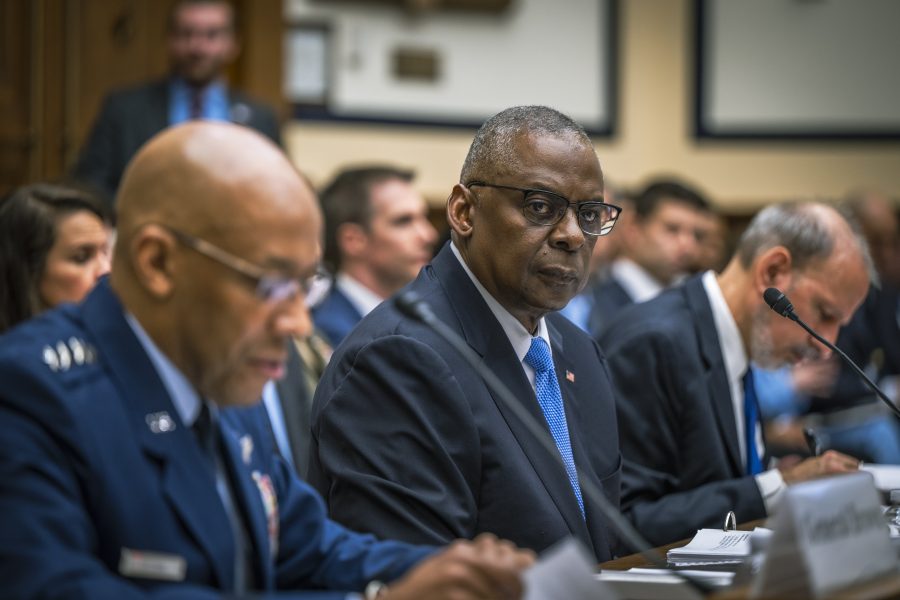Secretary of Defense Lloyd J. Austin III rebuffed criticism from lawmakers on April 30 that the F-35 program has proved too costly and unreliable to serve as the viable backbone of America’s and allies’ future fighter fleet.
“I would not categorize the F-35 as a paperweight,” Austin said in response to questioning from Rep. Matt Gaetz (R-Fla.) during a House Armed Services Committee hearing on the Department of Defense’s fiscal 2025 budget. “It is one of the best aircraft in the inventory.”
Concerns about the F-35 program have once more come to the fore recently following a Government Accountability Office report that said sustainment costs for F-35 would rise to over $1.5 trillion over the program’s life.
The F-35 Joint Program Office took issue with the title of that report—“F-35 Sustainment: Costs Continue to Rise While Planned Use and Availability Has Decreased”—because it said a main driver of that increase was a fleet that would be in service longer, rather than new unforeseen issues, noting that the Department of Defense now plans to fly the F-35 through 2088 instead of 2077. Indeed, the GAO report stated that a key “reason for the increase in cost estimates is the extension of the service life of the aircraft.” Overall, the JPO said the report accurately highlighted known “affordability and readiness challenges.”
Austin said he did not disagree with the findings of the GAO report.
Gaetz took particular issue with the F-35’s mission-capable rate, a point he previously raised with Secretary of the Air Force Frank Kendall and Chief of Staff of the Air Force Gen. David W. Allvin during an April 17 hearing. In response to Gaetz, Kendall said the “operational availability” rate for Air Force F-35s is 55 percent, which he acknowledged was “not a good number.” But Kendall and Allvin disputed that the program was “failing,” as Gaetz claimed. Asked on April 30 by Gaetz whether the F-35 was a “failure,” Austin also said it was not.
“It’s a complex airframe,” said Austin, who testified alongside Chairman of the Joint Chiefs of Staff Air Force Gen. Charles Q. Brown Jr. and DOD comptroller Michael McCord. “There are a number of reasons why a platform could be not operational at any one given time.”
A major criticism of the F-35 program is contractor Lockheed Martin’s control over the intellectual property related to aircraft, the contractor’s struggle with delivering aircraft on time, and the massive cost of the program. Kendall—the former chief Pentagon weapons buyer—has been a vocal critic of how the program was originally envisaged years ago, and Allvin also noted those concerns earlier this month.
“Lockheed Martin has more power than in some other weapons systems,” Allvin said.
The Department of Defense is currently waiting on the Technology Refresh 3 upgrade to the jet, which Lockheed Martin executives said recently has been pushed back until 2025. The DOD has not been accepting new F-35s until TR-3 is ready, though Lockheed Martin and F-35 Joint Program Office head Air Force Lt. Gen. Michael Schmidt have said the Pentagon may begin taking delivery of jets with a “truncated” version of TR-3 later this year. In his written testimony to the committee, Austin noted the fiscal 2025 budget contains over $61 billion to “assure U.S. air dominance,” including for the F-35.
“This includes continued funding for the modernization and sustainment of the F-35 and F-22 fleets while developing the next-generation fighters and autonomous collaborative combat aircraft critical to maintaining superiority in the skies,” Austin wrote.
During the hearing, Austin acknowledged that the program has had issues but indicated that he supported long-term plans for the F-35.
“I agree in the future we should take [and] we should have a different approach,” Austin said. “We continue to work to make sure that we get our aircraft operational.”
